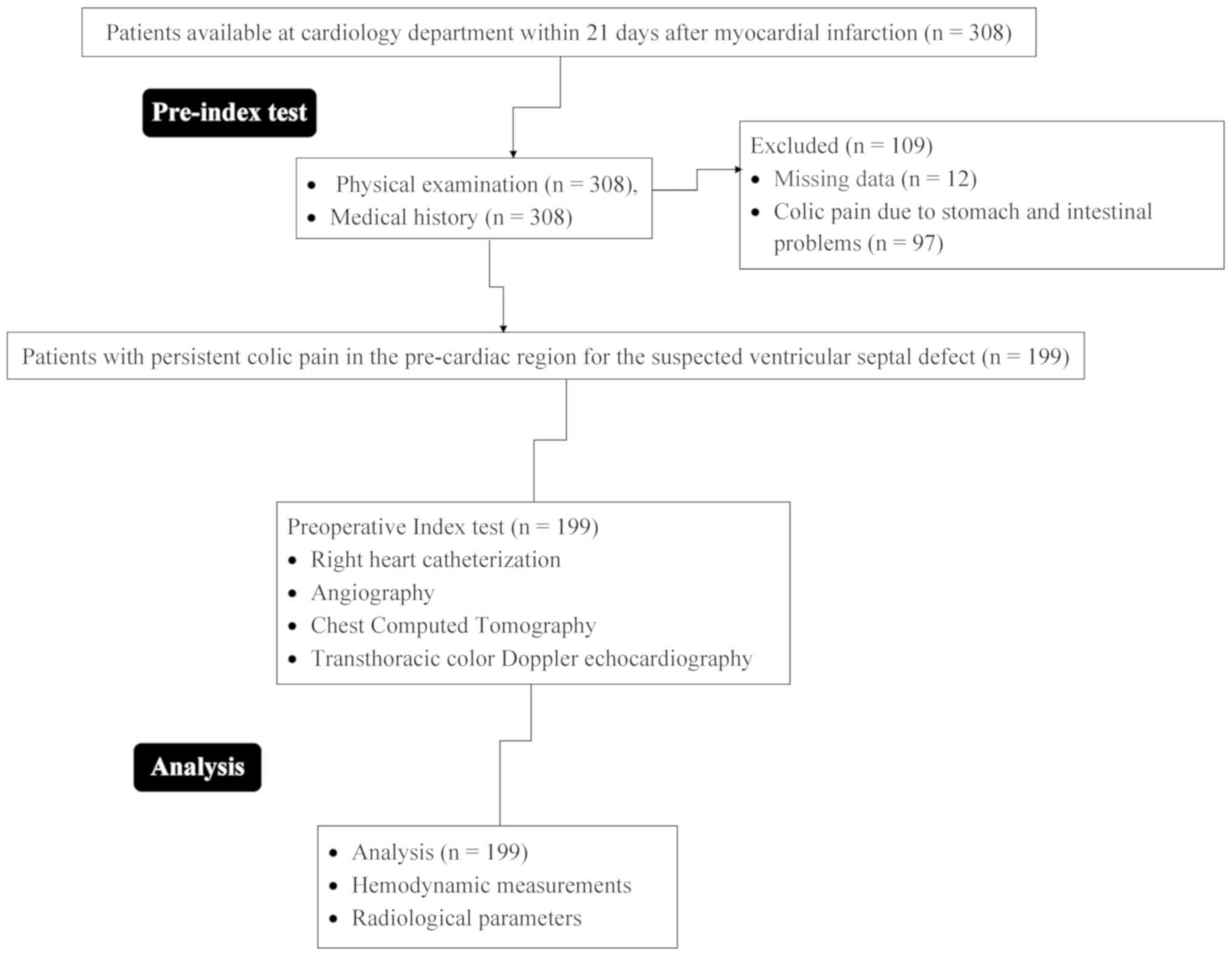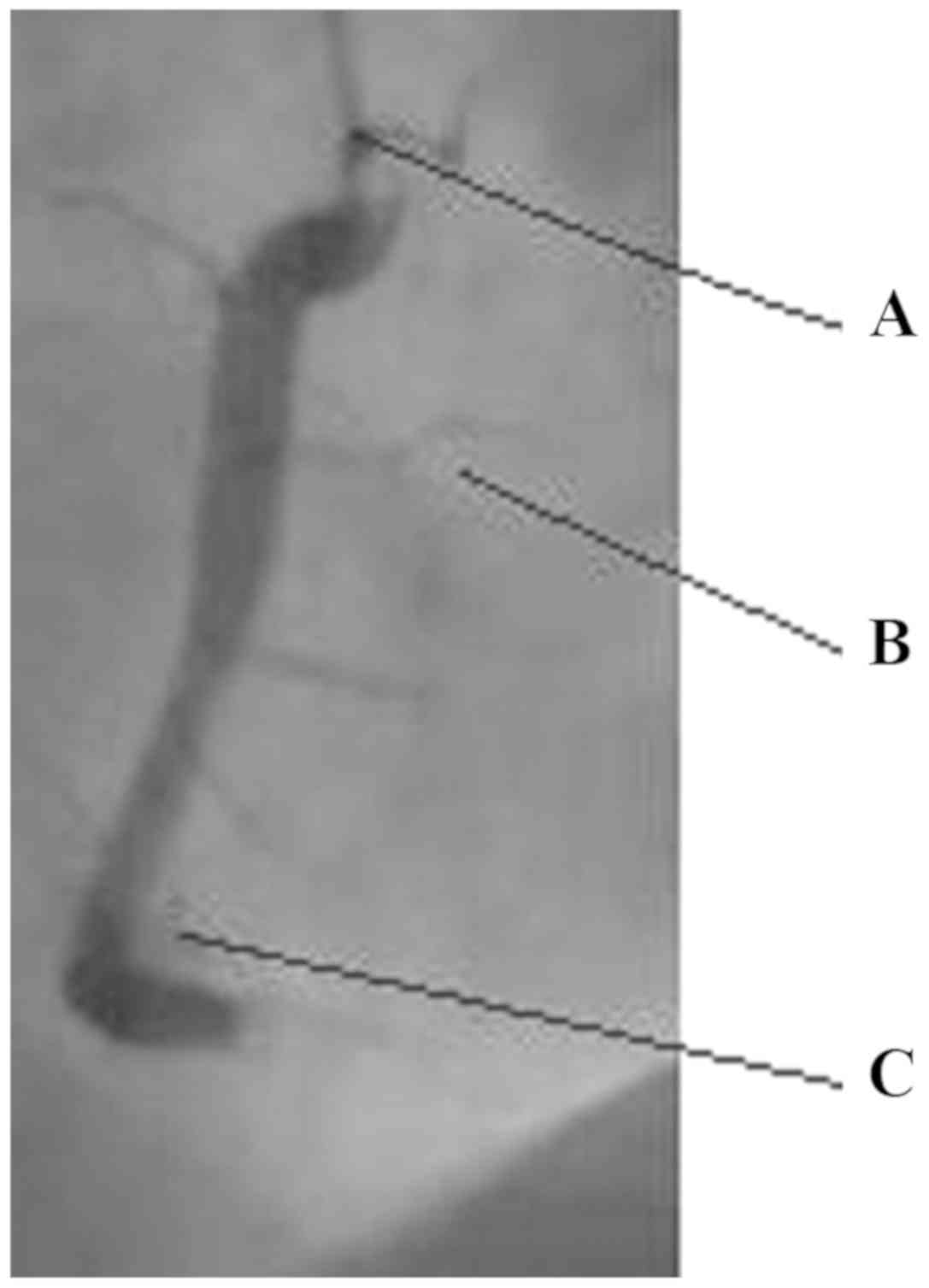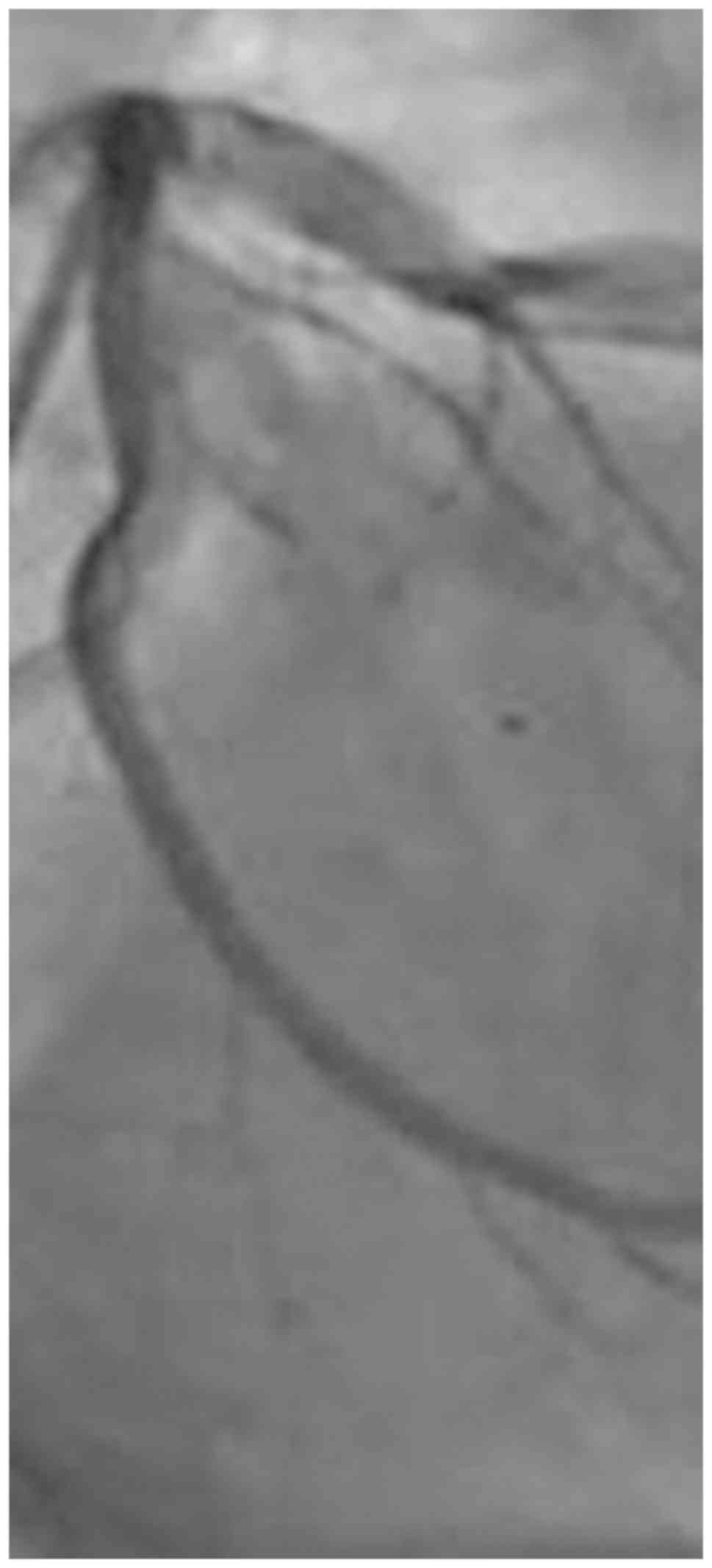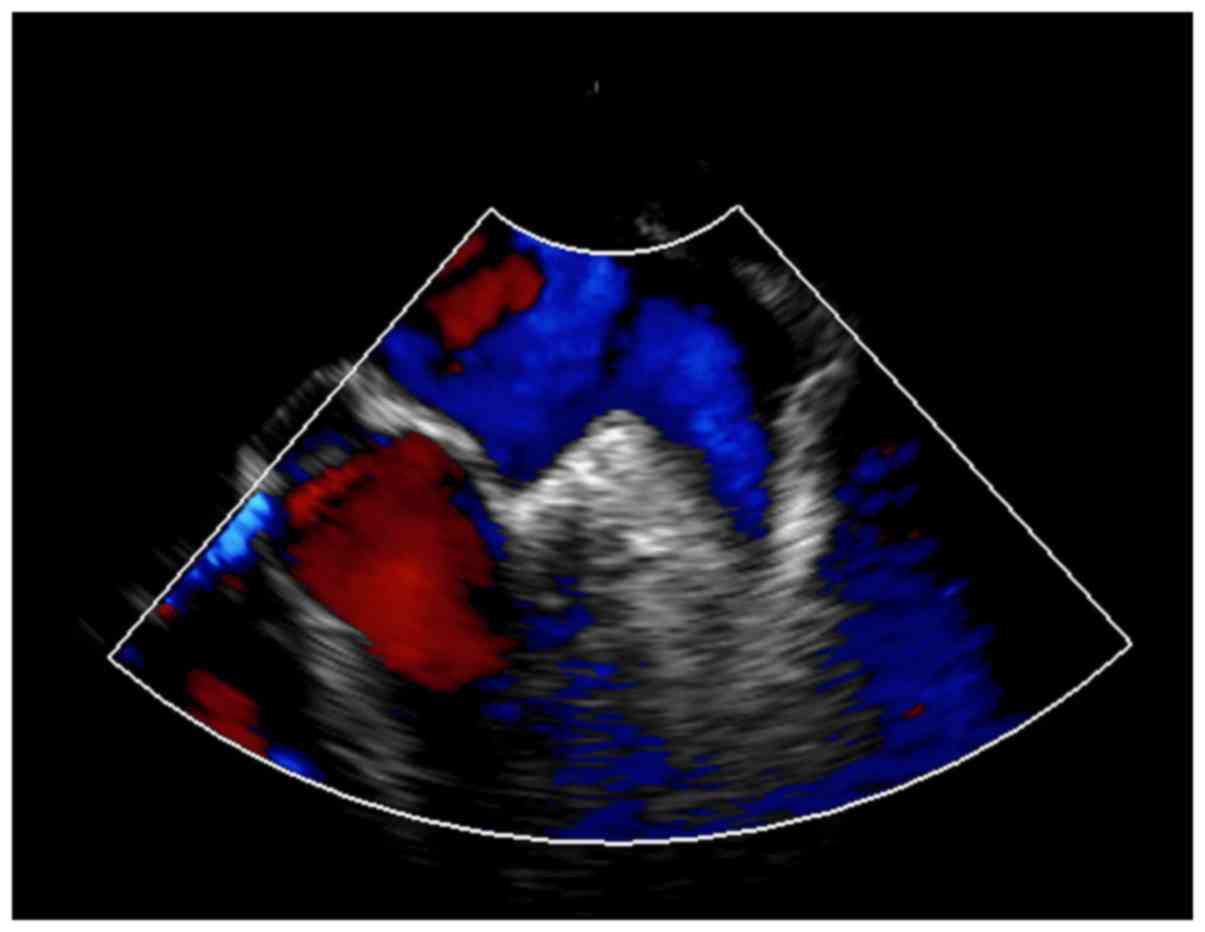|
1
|
Marzlin KM: Ventricular aneurysm:
Diagnosis and treatment. AACN Adv Crit Care. 28:391–394.
2017.PubMed/NCBI View Article : Google Scholar
|
|
2
|
Belkhadir M, MoutakiAllah Y, Raissouni Z,
Abdou A, Bamous M, Nya F, Atmani N, Houssa MA, El Bekkali Y and
Boulahya A: Left ventricular aneurysm and interventricular
communication complicating myocardial infarction. Pan Afr Med J
(French). 17(321)2014.PubMed/NCBI View Article : Google Scholar
|
|
3
|
Cho JH, Sattiraju S, Mehta S and Missov E:
Delayed ventricular septal rupture complicating acute inferior wall
myocardial infarction. BMC Res Notes. 6(124)2013.PubMed/NCBI View Article : Google Scholar
|
|
4
|
Kaluzna-Oleksy M, Araszkiewicz A, Migaj J,
Lesiak M and Straburzyńska-Migaj E: ‘From right to left’: The role
of right heart catheterization in the diagnosis and management of
left heart diseases. Adv Clin Exp Med. 26:135–141. 2017.PubMed/NCBI View Article : Google Scholar
|
|
5
|
Hakuno D, Isobe S, Masaki N and Adachi T:
Right ventricular wall dissection with ventricular septal rupture
following myocardial infarction visualized on 3-dimensional
transthoracic echocardiography. Circ J. 79:2072–2074.
2015.PubMed/NCBI View Article : Google Scholar
|
|
6
|
Nagueh SF, Smiseth OA, Dokainish H,
Andersen OS, Abudiab MM, Schutt RC, Kumar A, Gude E, Sato K, Harb
SC and Klein AL: Mean right atrial pressure for estimation of left
ventricular filling pressure in patients with normal left
ventricular ejection fraction: Invasive and noninvasive validation.
J Am Soc Echocardiogr. 31:799–806. 2018.PubMed/NCBI View Article : Google Scholar
|
|
7
|
Trivedi KR, Aldebert P, Riberi A, Mancini
J, Levy G, Macia JC, Quilicci J, Habib G and Fraisse A: Sequential
management of post-myocardial infarction ventricular septal
defects. Arch Cardiovasc Dis. 108:321–330. 2015.PubMed/NCBI View Article : Google Scholar
|
|
8
|
Shah S, Boyd G, Pyne CT, Bilazarian SD,
Piemonte TC, Jeon C and Waxman S: Right heart catheterization using
antecubital venous access: Feasibility, safety and adoption rate in
a tertiary center. Catheter Cardiovasc Interv. 84:70–74.
2014.PubMed/NCBI View Article : Google Scholar
|
|
9
|
Doutreleau S, Canuet M, Enache I, Di Marco
P, Lonsdorfer E, Oswald-Mammoser M and Charloux A: Right heart
hemodynamics in pulmonary hypertension-An echocardiography and
catheterization study. Circ J. 80:2019–2025. 2016.PubMed/NCBI View Article : Google Scholar
|
|
10
|
Galie N, Hoeper MM, Humbert M, Torbicki A,
Vachiery JL, Barbera JA, Beghetti M, Corris P, Gaine S, Gibbs JS,
et al: Guidelines for the diagnosis and treatment of pulmonary
hypertension: The task force for the diagnosis and treatment of
pulmonary hypertension of the European Society of Cardiology (ESC)
and the European Respiratory Society (ERS), endorsed by the
International Society of Heart and Lung Transplantation (ISHLT).
Eur Heart J. 30:2493–2537. 2009.PubMed/NCBI View Article : Google Scholar
|
|
11
|
Rudski LG, Lai WW, Afilalo J, Hua L,
Handschumacher MD, Chandrasekaran K, Solomon SD, Louie EK and
Schiller NB: Guidelines for the echocardiographic assessment of the
right heart in adults: A report from the American Society of
Echocardiography endorsed by the European Association of
Echocardiography, a registered branch of the European Society of
Cardiology, and the Canadian Society of Echocardiography. J Am Soc
Echocardiogr. 23:685–713. 2010.PubMed/NCBI View Article : Google Scholar
|
|
12
|
Beigel R, Cercek B, Luo H and Siegel RJ:
Noninvasive evaluation of right atrial pressure. J Am Soc
Echocardiogr. 26:1033–1042. 2013.PubMed/NCBI View Article : Google Scholar
|
|
13
|
Kouzu H, Nakatani S, Kyotani S, Kanzaki H,
Nakanishi N and Kitakaze M: Noninvasive estimation of pulmonary
vascular resistance by Doppler echocardiography in patients with
pulmonary arterial hypertension. Am J Cardiol. 103:872–876.
2009.PubMed/NCBI View Article : Google Scholar
|
|
14
|
Nand N, Singla SK and Magu S: Cardiac
abscess with ventricular aneurysm secondary to old myocardial
infarction. J Assoc Physicians India. 65:95–96. 2017.PubMed/NCBI
|
|
15
|
Fisher MR, Forfia PR, Chamera E,
Housten-Harris T, Champion HC, Girgis RE, Corretti MC and Hassoun
PM: Accuracy of Doppler echocardiography in the hemodynamic
assessment of pulmonary hypertension. Am J Respir Crit Care Med.
179:615–1621. 2009.PubMed/NCBI View Article : Google Scholar
|
|
16
|
Kasai H, Matsumura A, Sugiura T, Shigeta
A, Tanabe N, Yamamoto K, Miwa H, Ema R, Sakao S and Tatsumi K: Mean
pulmonary artery pressure using echocardiography in chronic
thromboembolic pulmonary hypertension. Circ J. 80:1259–1264.
2016.PubMed/NCBI View Article : Google Scholar
|
|
17
|
Aduen JF, Castello R, Daniels JT, Diaz JA,
Safford RE, Heckman MG, Crook JE and Burger CD: Accuracy and
precision of three echocardiographic methods for estimating mean
pulmonary artery pressure. Chest. 139:347–352. 2011.PubMed/NCBI View Article : Google Scholar
|
|
18
|
Saggar R and Sitbon O: Hemodynamics in
pulmonary arterial hypertension: Current and future perspectives.
Am J Cardiol. 110 (Suppl):9S–15S. 2012.PubMed/NCBI View Article : Google Scholar
|
|
19
|
Nagy AI, Venkateshvaran A, Dash PK,
Barooah B, Merkely B, Winter R and Manouras A: The pulmonary
capillary wedge pressure accurately reflects both normal and
elevated left atrial pressure. Am Heart J. 167:876–883.
2014.PubMed/NCBI View Article : Google Scholar
|
|
20
|
Hoeper MM, Bogaard HJ, Condliffe R, Frantz
R, Khanna D, Kurzyna M, Langleben D, Manes A, Satoh T, Torres F, et
al: Definitions and diagnosis of pulmonary hypertension. J Am Coll
Cardiol. 62:D42–D50. 2013.PubMed/NCBI View Article : Google Scholar
|
|
21
|
Vlahos AP, Feinstein JA, Schiller NB and
Silverman NH: Extension of Doppler-derived echocardiographic
measures of pulmonary vascular resistance to patients with moderate
or severe pulmonary vascular disease. J Am Soc Echocardiogr.
21:711–714. 2008.PubMed/NCBI View Article : Google Scholar
|


















